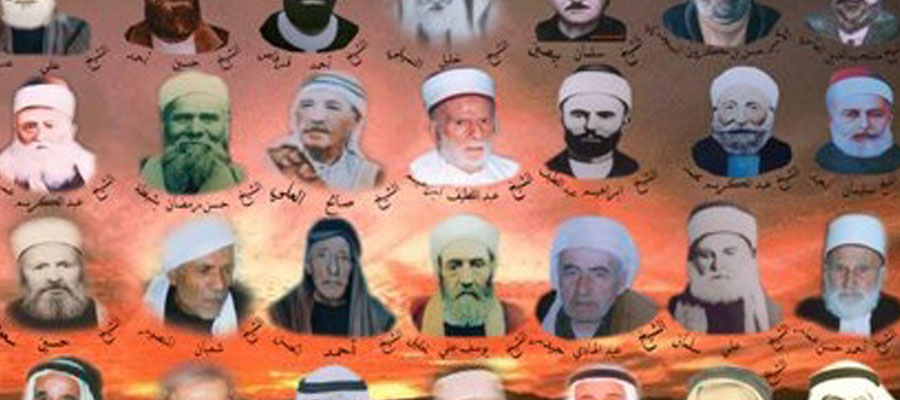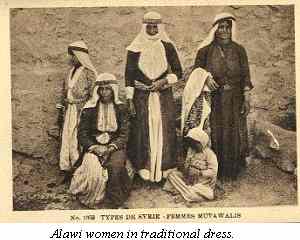Nusayri Sect:The Concept of Clans The lifestyle of Nusayris/Alawites

By:Issam Khoury
July/15/2008
 Nusayri Muslims are still leading a clan lifestyle in their mountains. Even those who inhabited the city, were poorly influenced by the city life in
Nusayri Muslims are still leading a clan lifestyle in their mountains. Even those who inhabited the city, were poorly influenced by the city life in
favor of their clan roots
Leader of the Clan
All members of a clan are closely connected to each other concerning all aspects of life, by means of principles depending on obedience and respect towards the head of the clan, or the Alzaeem. This is especially so when a conflict or misunderstanding occurs between one clan and another, or between a clan and other religious sects, while distributing their share of the Diye, or the ransom between themselves, as is the case with the Al-Badawi Arab Clans
However, if the head of a certain clan (Zaeem) is powerful enough, the extreme obedience of his followers reveals their obedience to the government. So, when this leader opposes the government, members of his clan will show their discontent of the government, through all means.The leader of each clan inherits his leadership from his father or brother and only then is he considered as the most respectable person in the clan. Powerful individuals may exist in a clan who get ahead by their strength, influence and intelligence, or through close ties to the political authority, without having any rooted clan pedigree. After their death, their sons inherit the leadership again. However, the more interest and authority shown by new leaders in the absence of any rivalry clan, the higher their position becomes when they take on an absolute rule
In the Past
Alawites have always required a clan leader to deter them from the anger of the government, injustice of their workers and the transgression of other clan members.The Zaeem clan which had no leader was harmed to a great extent, where they suffered and were harmed by government workers. Clan tax collectors would harass them by any means. This resulted in families consolidating with other tribes, particularly those who had a significant leader and strong men to protect them.
The Representatives: (Al- Ayan)
After the clan leader comes the position of Al- Aghawat and Al-Mukadimeen. Their influence usually covers small villages but could expand over a group of villages, and it may even reach an entire country
Men of Religion: (Al-Mashayekh)
They are greatly respected in society and obtain countless privileges. The most important privilege is Alzakat, the almsgiving that they obtain from believers and non believers by means of embarrassment. The amount of alms differ according to the financial position of the person from one side, and the state of sheikh from another. It comes as no surprise that the commons used to consider it as a different kind of an ascending tax. The position of the Sheikh was also inherited in the absence of institutions teaching religion.
Religious studies were restricted between the Sheikh and those who desired to study it. The more committed a student was, the greater his knowledge of this religion will be. The Alawite religion consists of studying gradually until someone achieves the position of Sheikh.
Due to the amount required to study (24 years continuously), the student could become poor, which makes alms the only way to compensate the long years he served under the authority of his master, the oldest Sheikh. Sheikhs play a significant role inside Nusayri social life, and are represented by the following
- Teaching the Quran and concentrating on the Arabic language, which lowered the rate of illiteracy in the mountain regions of Nusayris
- Preserving their practices from being uncovered, choosing personalities capable of maintaining their secrecy and continue working to achieve its purpose. Whereas, the negative role of the Sheikhs was in their multiplicity, and the constant endeavor to enlarge their circle of acquaintances, in an attempt to widen influence and obtain the greatest amount of alms. This led to numerous beliefs that might seem illogical, but allowed a Sheikh or another to benefit from it.
Nusayri injustice and oppression complex
The Alawite religion by root, differs completely from the Muslim sect. Due to the fact that authority in Syria throughout history was held by the Muslim majority (Sunni), Nusayris have suffered extreme oppression. This resulted in their settlement in the mountains in order to avoid that further
The oppression they experienced contributed to forming their current personality. Although at present, some members of the sect hold positions of authority in Syria. Yet, one can sense the constant worry of any reform against them, and the absence of the support which they receive
This feeling attributed to the increase of loyalty to the ruling family, which on it’s side also endeavored to maintain this by asking the help of religious Nusayri men. The men found this culture as a fundamental aspect for the continuity of their existence, as well as an excellent way to earn their living, regardless of social status. This enabled them to solve all problems and obtain their needs

Nusayris throughout history
This group traces back to their leader Ibn Nusayr, also known as Abu Shu’ ayb. He was a disciple of the tenth Twelver Imam, and a Shia Muslim of Persian origin. He split upon a dispute concerning the position of Al Bab (loyal person to the inhabitants of the house, who is the link between the people and the hidden imam) where he claimed being Al Bab for the expected Muhammad al-Mahdi, and wasn’t admitted to it. Thus, he established his own sect and remained the leader until his death in the year 260 Hijri, some people claim that it was 270 Hijri. It has been thought that he was the Master of Hasan al-Askari, the eleventh Imam of Shia Islam
Conflict between the Twelfth Imam and Nusayris
The death of Askari the eleventh imam of Twelver Shia Islam, without anyone to replace him, gave way to a severe conflict amongst Shiites. They have parted into almost 14 groups, amongst people who approved the potential leadership of one of Askari’s sons, Muhammad, and groups who didn’t approve of Muhammad overall
A hidden imam to manage people’s affairs has always existed, or life wouldn’t go on. The imam wasn’t enough, they have come up with the idea of Al-Bab. To get to know the Babiye*** according to stories about the life of Prophet Muhammad: “He, who requests knowledge, let him ask Al-Bab. I am the city of knowledge and Ali is it’s door.” Thus, they established a list of ‘doors’. The first of which was Ali ibn Abi Talib, who was the door to the Prophet, and Salman Al Farisi who was the door to Ali until we reached the eleventh imam Askari
Then they had a disagreement based on their beliefs. Nusayris claimed that the twelfth imam Askari didn’t have a door, instead he continued as the follower to Ibn Nusayr. Starting from this point, the disagreement between Nusayris and the twelfth imam took place; this led to his separation of the twelfth. After the death of Ibn Nusayr, numerous significant personalities alternated in leadership positions, who influenced the Nusayri doctrine with their ideologies and opinions. The most significant of these were Abu Muhammad Al Jublani and his student Al Huseyn Bin Hamdan Al Khasibi, Muhammad Ibn Ali Al Jali, Ali Al Jasri , al Maymoun “Ibn Srour Bin Kasem Al Tabrani” and Hasan Al Makzoun Al Sinjary, who was the last representative of strength next to Nusayris
They are divided by means of origin into the Khayyateen and Sinjary*** clans
Al Khaiyatin clan: Arabic Origin
The origin of Khaiyatin groups traces back to the arabs who emigrated from southern Iraq at the end of the fourth century Hijri, during the disturbance of Baghdad, to the coastal town Banias in the southern Latakia. This emigration occurred through a campaign led by their leader, who was later called ‘The Banyasi Isa’
AL HALABYYA al-Kalibiyya tribes**also joined them, coming from the Arabian Peninsula. They are closely related to the group of the leader ‘Isa’ Thus, their population grew vastly and they spread in Jabla, Misyaf, Al Markab and in the surrounding villages of Safita. The tribe’s name originated due to the name of their dignified Sheikh, Hamza al-Khayyat
The Khaiyatin tribe forms seven main sects
al-Khayyats, al-Faqaqra, al Abdyia, Al Halabia and al-Amamra***AL KHAYYATS, AL FAQAWRA, AL ABDYIA,
AL SARAMTA, AL HALABYYA, AL AMAMRA
Al Sinjary clans: Kurdish Origin (3)
Nusayris were subjected to many attacks by their Sunnu Kurdish neighbors and by Ismailis. This required holding a meeting by Nusayri supervisors in the year 593 Hijri in the town of Banyas. They decided to ask for the help of their relatives in religion, who inhabited the Sinjar mountains, and were led by ***Prince Hasan bin Yousef bin Makzoun. He responded to their demands through two attacks. The first attack was in 610 Hijri under the leadership of Al Amir**** (Prince) Hasan led around five thousand fighters.
The result of this attack was his dominance on Al Madiq castle and Al Al Alekhya castle, where after he got married to the cousin of Sheikh Hamza al-Khayyat. However, after his defeat in the battle of Misyaf (4), he went back to the Sinjar mountains in the year 613 Hijri (5).
The second attack: was in the year 620 Hijri, once again under the leadership of Al Amir. This time the number of fighters reached over 20,000. Hasan dominated the mountains of Latakia after his control over the castle of Abu Qubais and Misyaf, where Nusayri and al Sinjari clans spread over Nusayri mountains, after discovering the climate there was better than the climate in the region of Sinjar.
Emigration
As a result to the Shia-Sunni conflict, the Sultan Muhammad Bin Kalawaan decided to “Purify Islam of the Apostates”
Thus, he fought with the Shia in Kisirwan*** and caused many of them to escape towards the al Alya** mountains. The same thing happened to Nusayris who ran from Palestine and northern Egypt towards the mountains of Latakia and Jabal Mohsen area, north of Tripoli
Al-Sanjari clans are divided into three
Al-Haddadin clans, which consists of eight sects: the Haddad, the Alis, the Yashout, Al-Mahaliba, Al-Bashalowa, Al Rakawna, Al-Ataryia, Al Shamasna.
Al Matawra groups and their eight sects: Al Matawra, Al Jawamra, Al Sawarma, Al Nmylatyia, Al Dawasa, Al Bshargha, Al Arajna and Al Maharza.
Al Kalbyia clans, they form seven sects: Al Kalbyia, Al Rashawna, and Al Jroud, Al Karahla, Al Rasalna, Al Nawarsa, the Shalfs, the Alis, the Ahmad, and the Muhammad.****
Foot Notes
Al Aghawat are the most honorable people in the region and they include significant personalities such as scientists, intellectuals and rich. They could be of Christian religion in some cases. Al Aghawat meet with the leader of the clan and present their suggestions and solutions concerning disasters that occurs in the clan or in the region.
Al Mukdims are honorable people within the clan. They carry the task of collecting taxes that are determined by the leader to be given to the state previously from the commons in the clan. When he is chosen and is fully aware of the financial affairs of his people, so that he could find a balance between the poor, the moderate and the rich while collecting taxes. Nowadays the Mukdims don’t exist due to the absolute control of the state over the region. However, their grandchildren are still looked at as highly respected due to their ancient origin.*****
The region of Sinjar Mountain has a semi complete majority of Kurds. Most of their religious belief stands on Al_batiniye, where some of them belong to Al_Nuseyri_Kurds and Al_Kurdi Yazidi “who compose the majority at the present” and some minor followers to the hidden religion of Al_Sabiaa, accompanied by some minorities of Al_Ashouries and Kildanies. Due to this fact, I personally assume that the Sinjari clans descent from Kurdish origins.
According to the estimations of Dr. Asaad Ali “The book knowing Al_Makzoon page 343”.
Books and References:
- Al-Sharif, Munir Al-Muslimeen and Al Alawiyouna
(About the Alawites and their independent state)
– Muhammad Hawash, published by Dr. Gassan Hawash 1997 Casablanca, Morocco***



